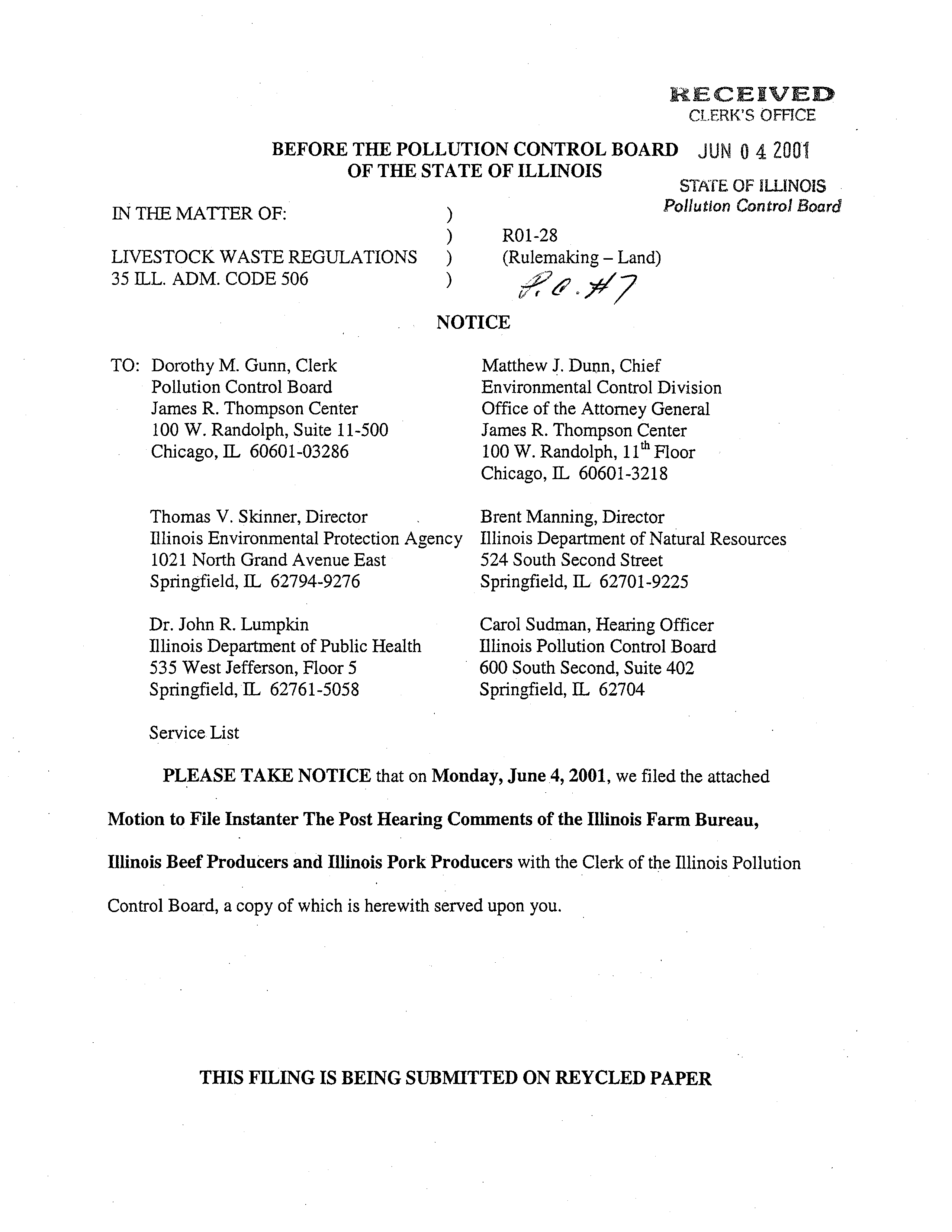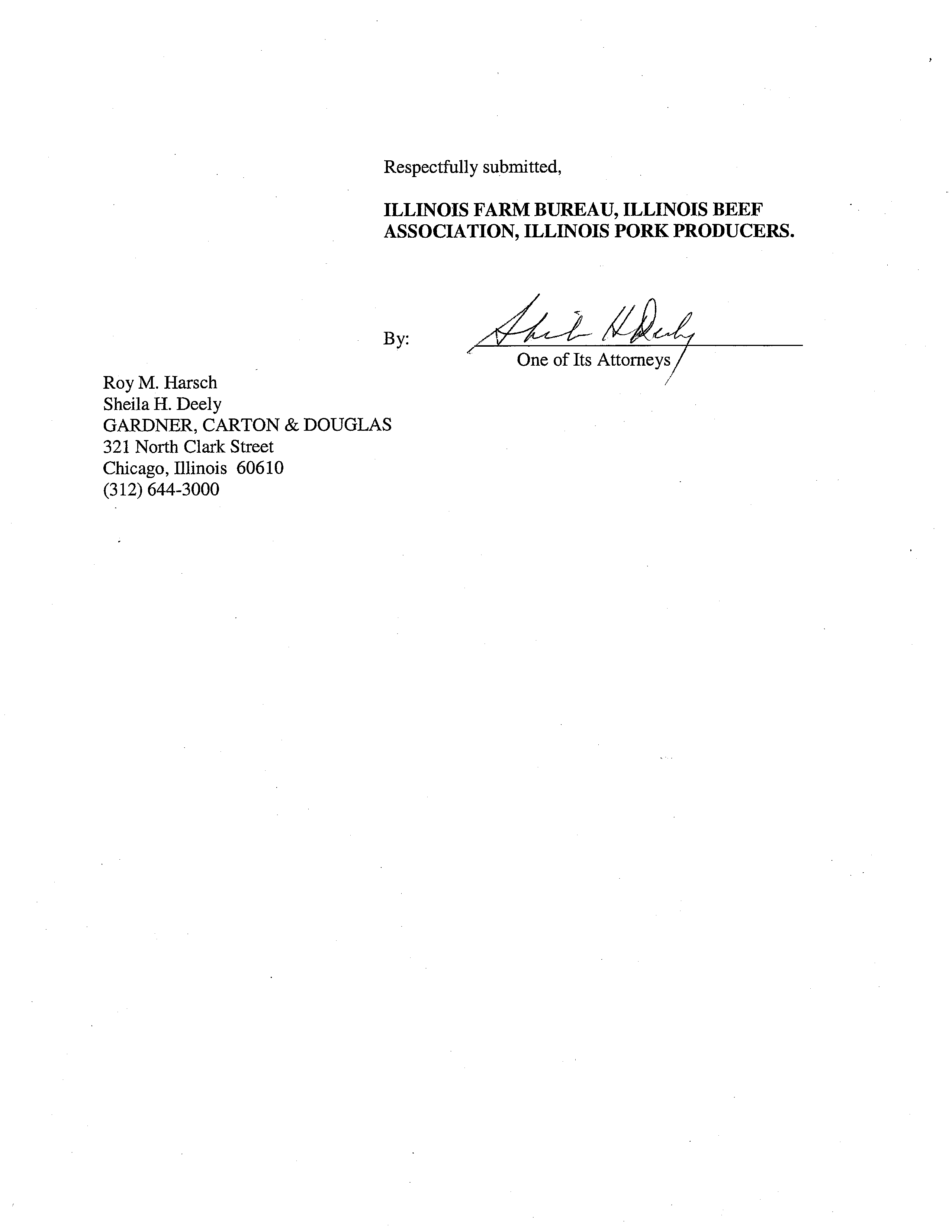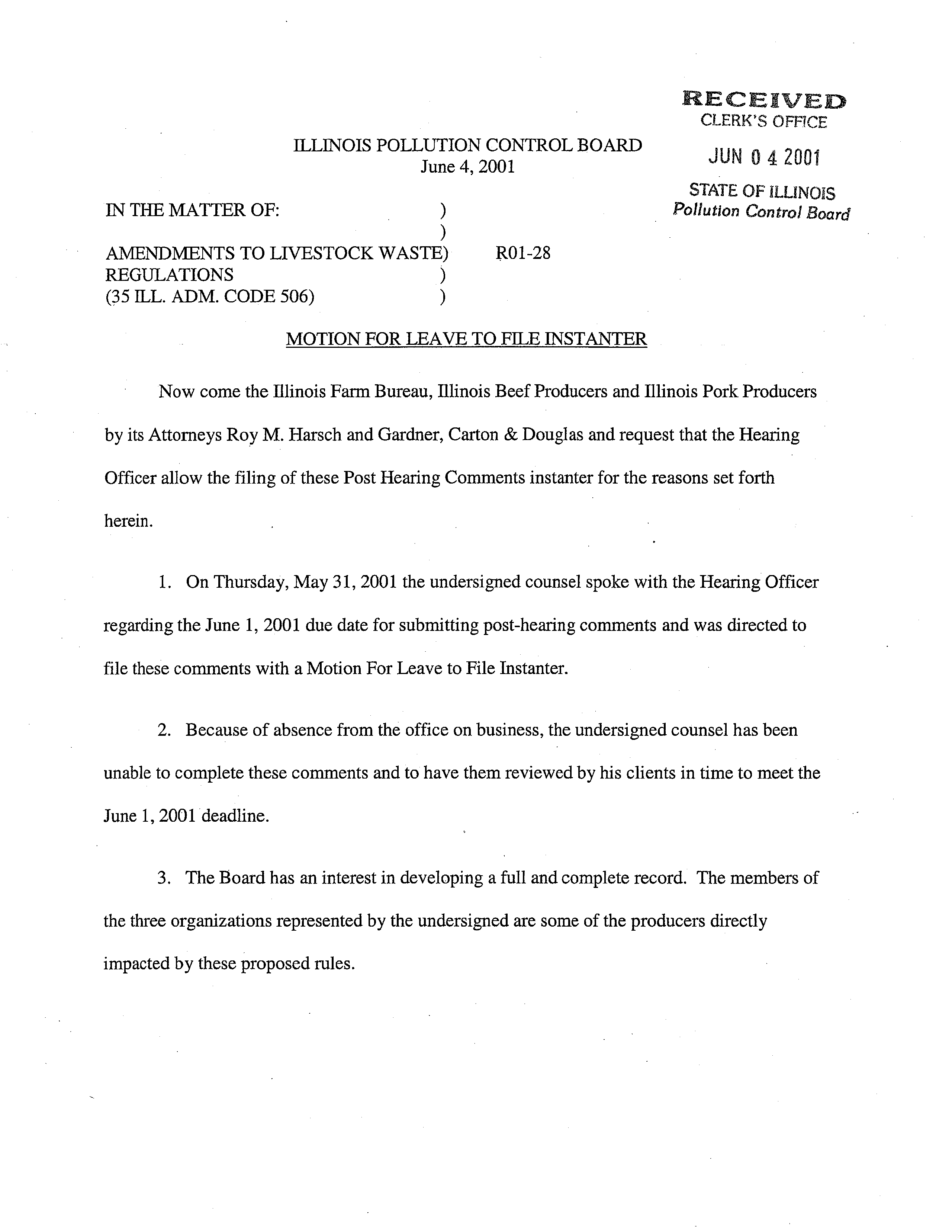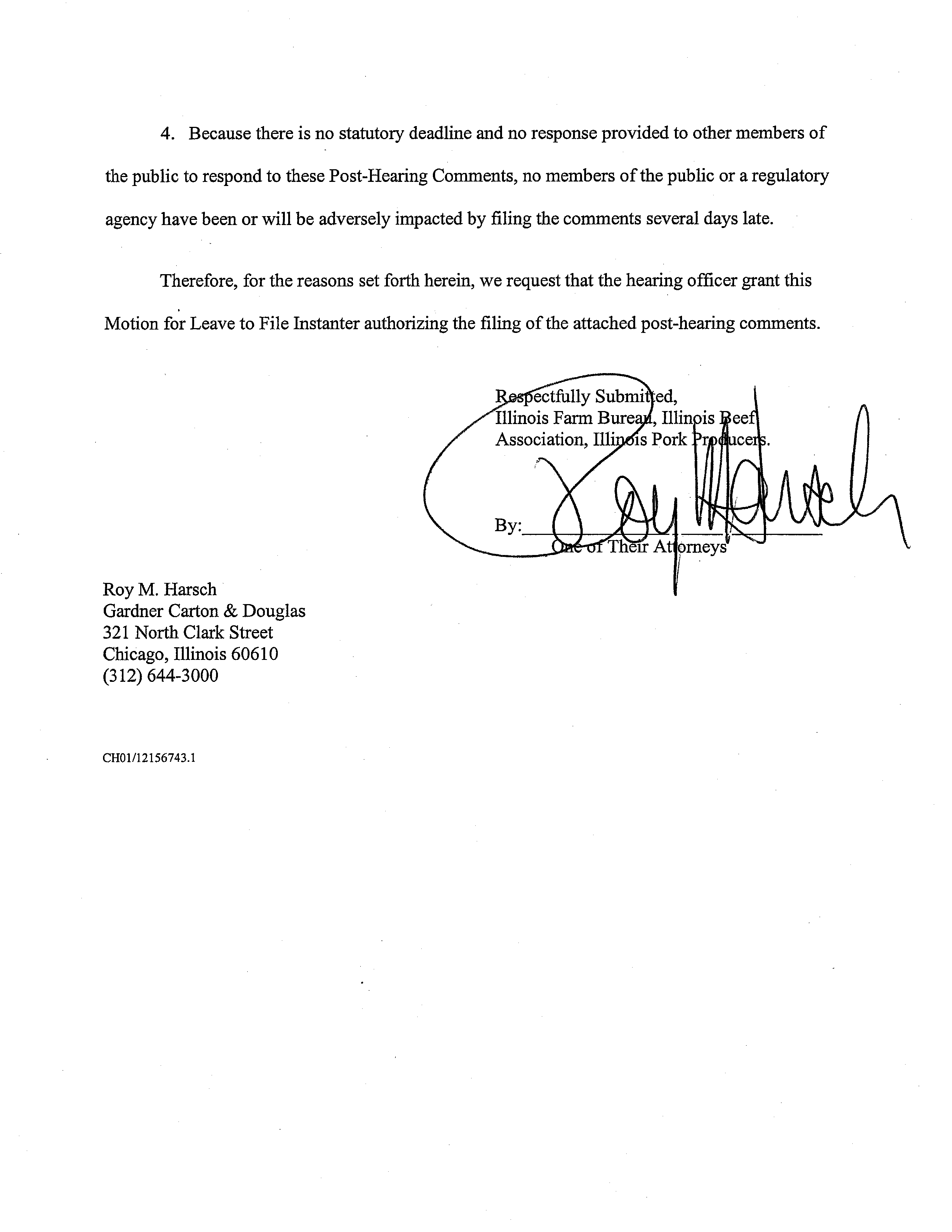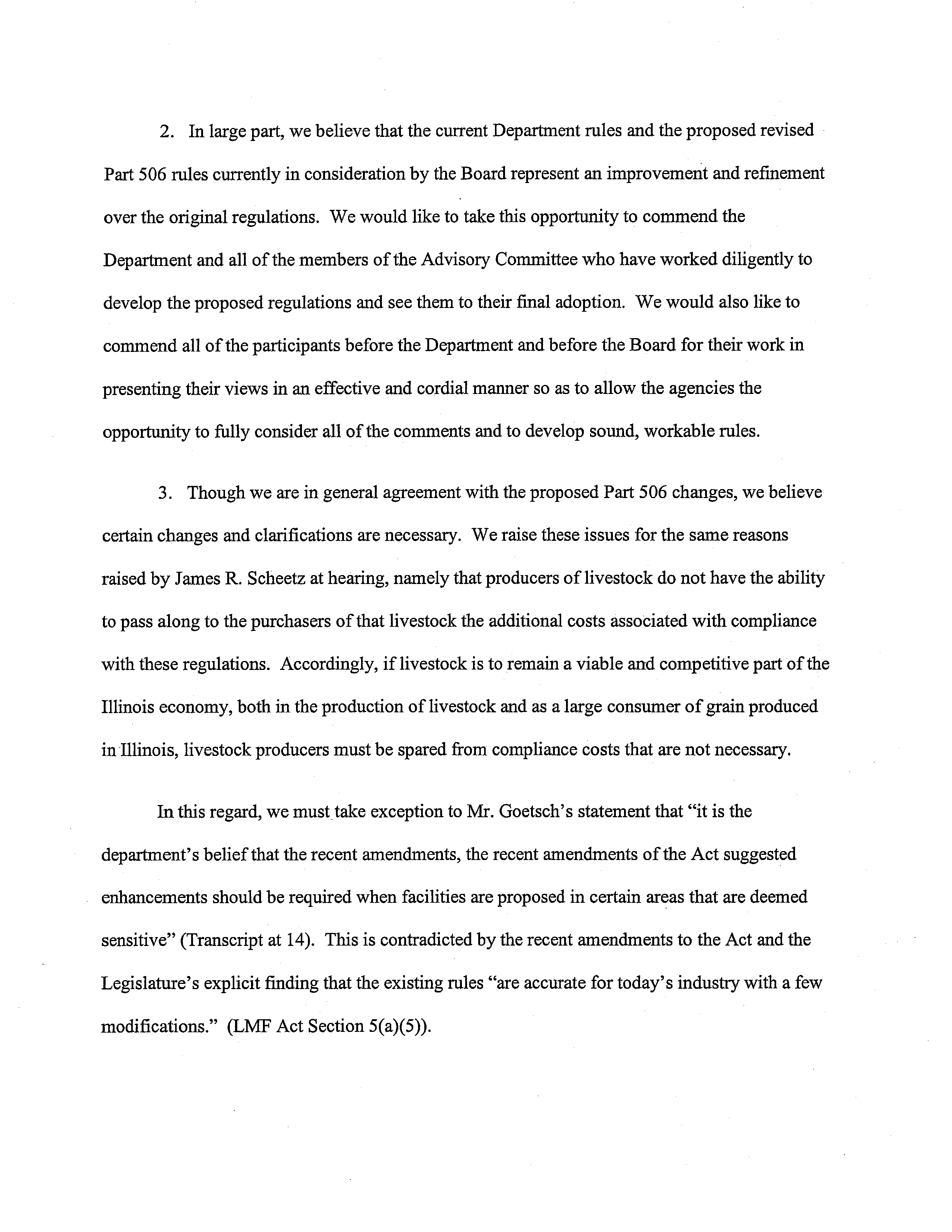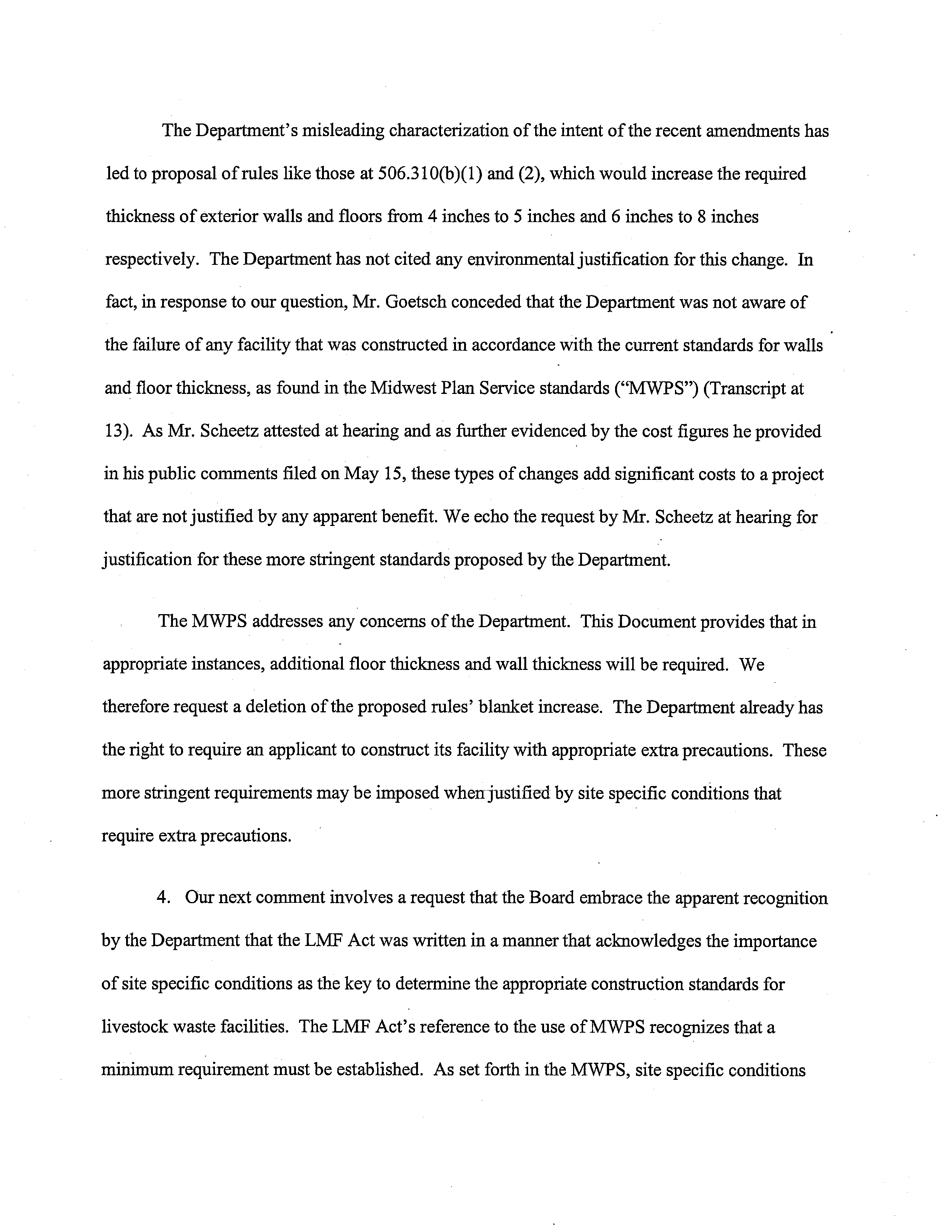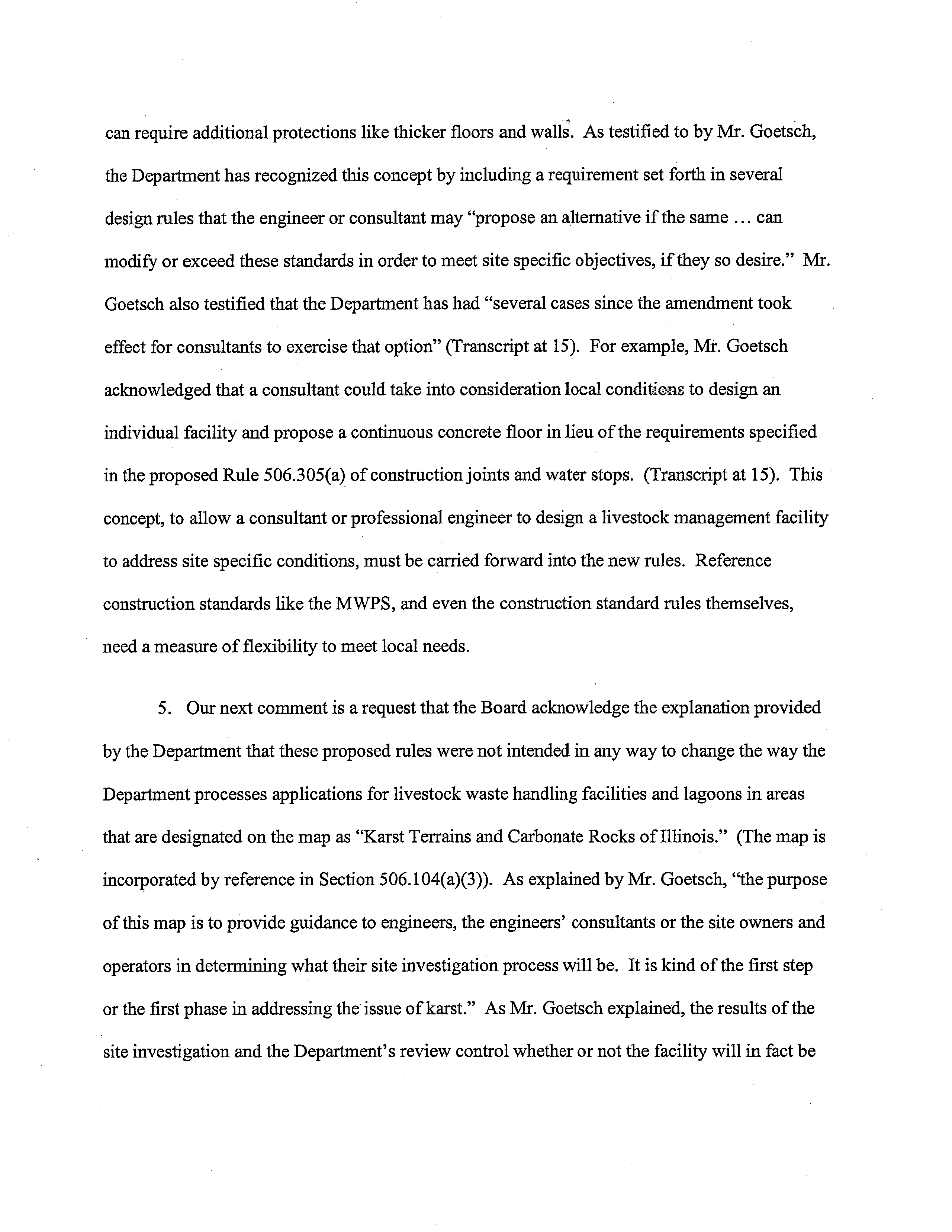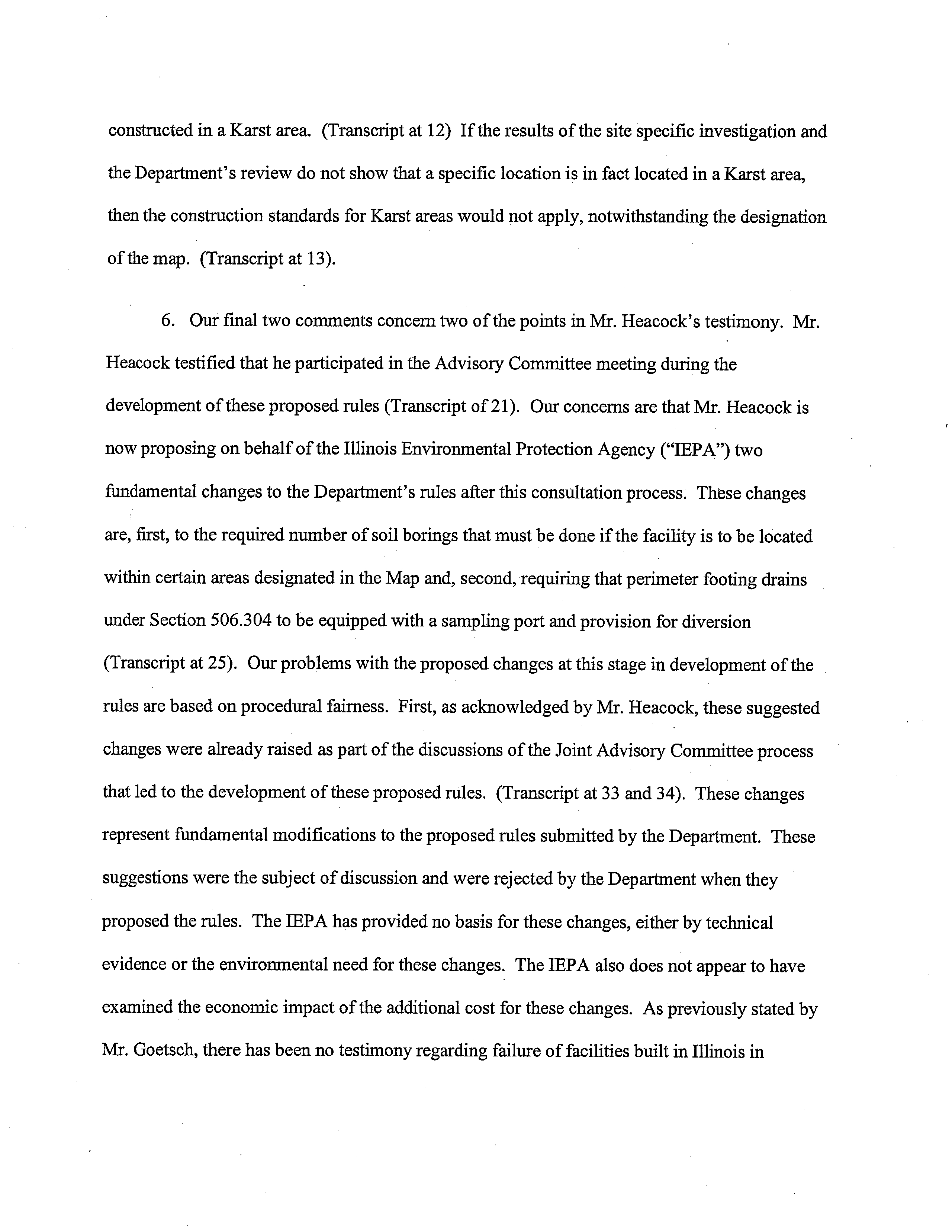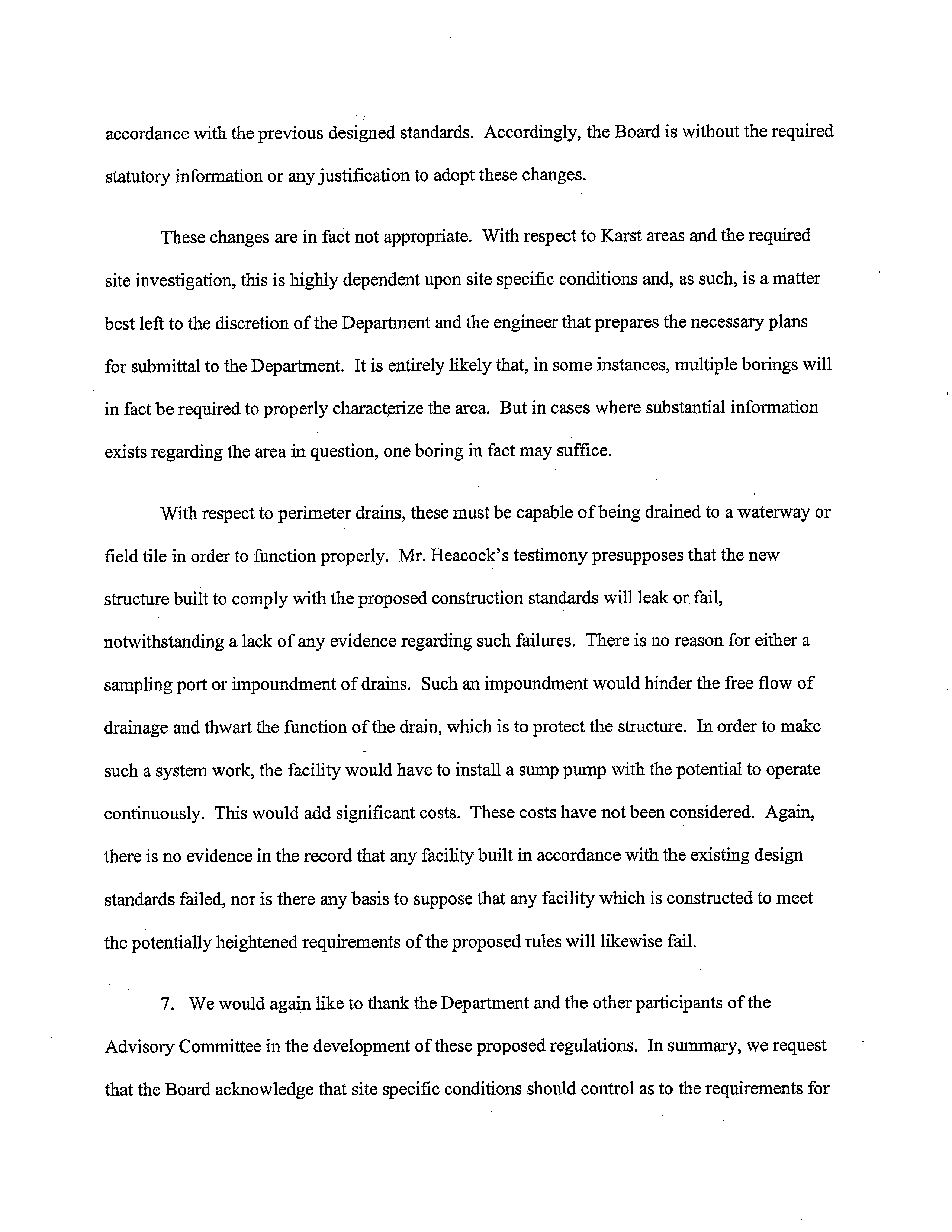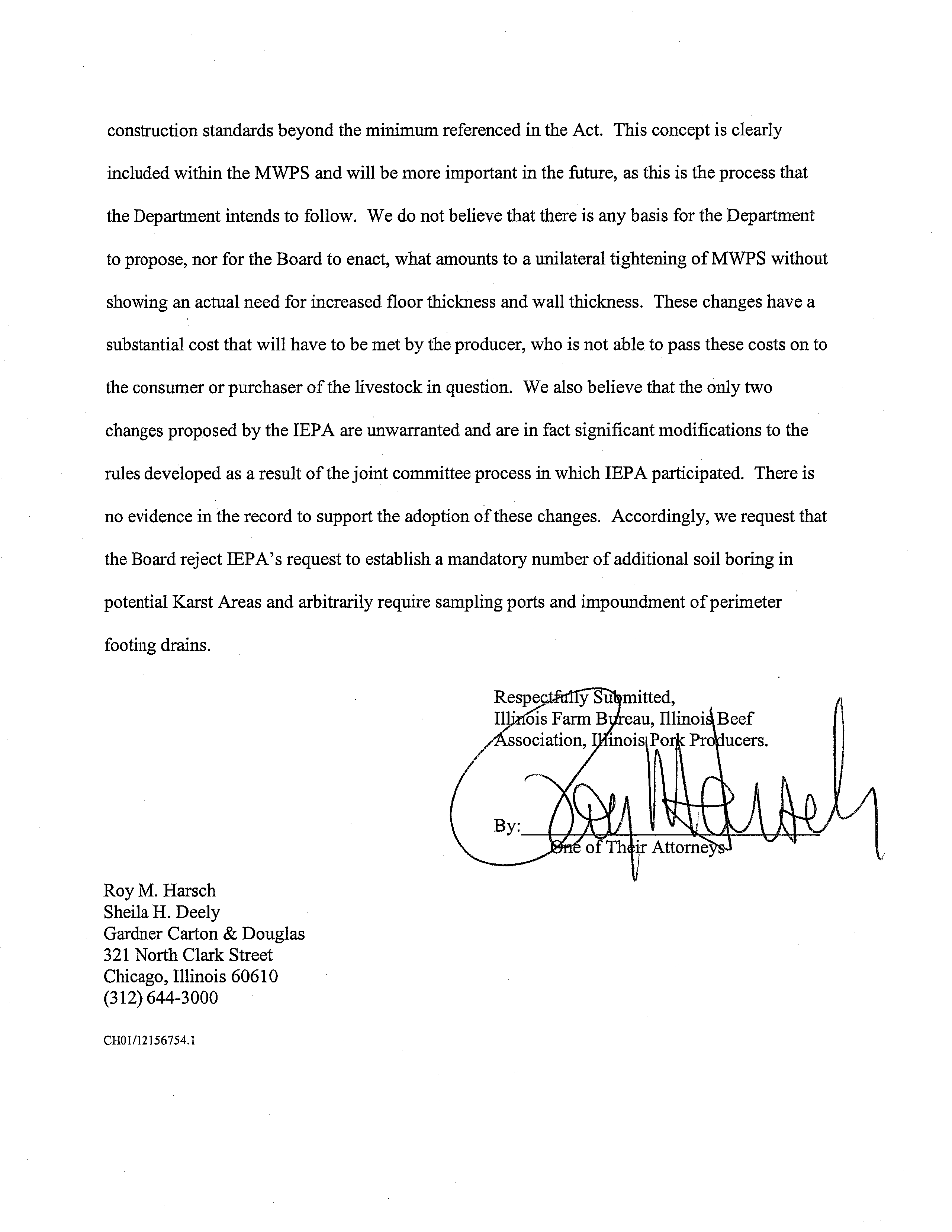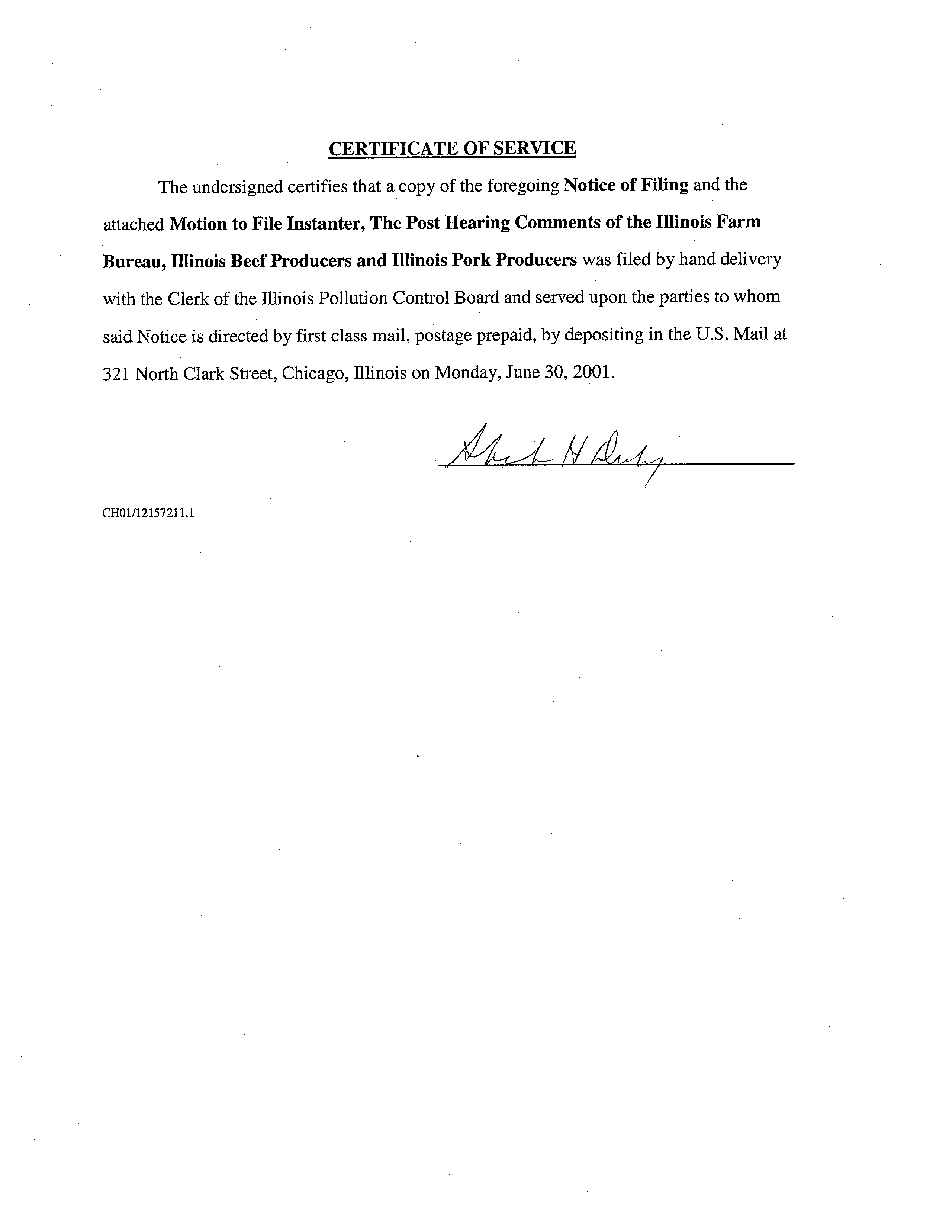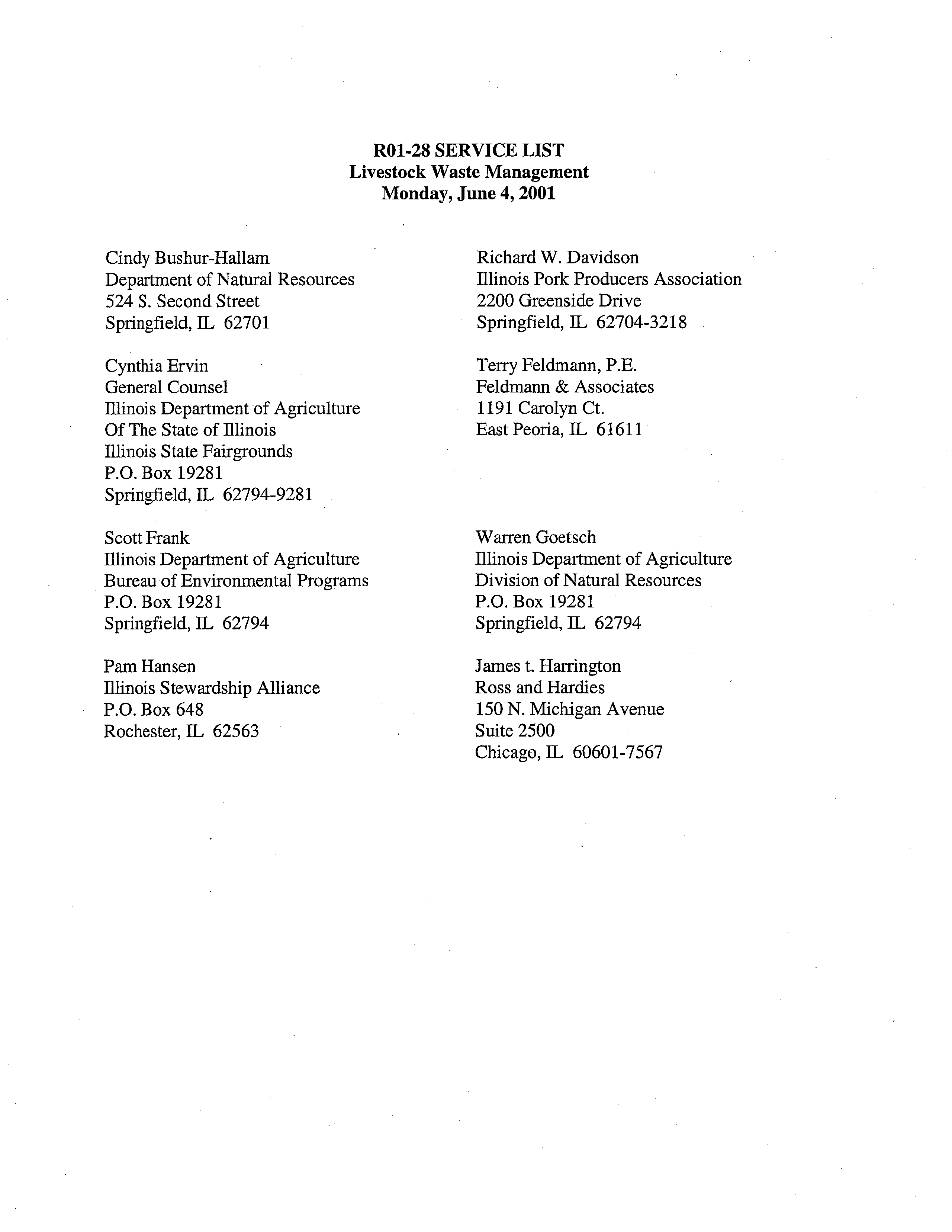k~.ECEIVED
ClERK’S OFFICE
BEFORE THE POLLUTION CONTROL BOARD
JUN
0
4
2001
OF THE STATE
OF ILLINOIS
N THE MATTER OF:
)
LIVESTOCK WASTE REGULATIONS
35
ILL. ADM. CODE
506
STATE OF ILLINOIS
Pollution
control Board
)
RO1-28
)
(Rulemaking
—
Land)
NOTICE
TO:
Dorothy M. Gunn, Clerk
Pollution Control Board
James R. Thompson Center
100 W.
Randolph, Suite 11-500
Chicago, IL 60601-03286
Matthew J. Dunn, Chief
Environmental Control Division
Office of the Attorney General
James R. Thompson Center
100 W. Randolph,
1 1~ Floor
Chicago, IL
60601-3218
Thomas V. Skinner, Director
Illinois Environmental Protection Agency
1021
North Grand Avenue East
Springfield,
IL 62794-9276
Dr. John R. Lumpkin
Illinois Department of Public Health
535 West Jefferson, Floor 5
Springfield, IL
6276 1-5058
Brent Manning, Director
Illinois Department ofNatural Resources
524
South Second Street
Springfield, IL
62701-9225
Carol Sudman, Hearing Officer
Illinois Pollution Control Board
600 South Second, Suite 402
Springfield, IL
62704
Service List
PLEASE TAKE NOTICE
that on
Monday, June 4,
2001, we filed the attached
Motion to File Instanter The Post Hearing Comments of the Illinois Farm Bureau,
Illinois Beef Producers and Illinois Pork Producers
with the Clerk of the Illinois Pollution
Control Board,
a
copy of which is herewith served upon you.
THIS FILING IS BEING SUBMITTED ON REYCLED PAPER
Respectfully submitted,
ILLINOIS FARM BUREAU, ILLINOIS BEEF
ASSOCIATION, ILLINOIS PORK PRODUCERS.
By:
Roy M. Harsch
Sheila H. Deely
GARDNER, CARTON & DOUGLAS
321 North Clark Street
Chicago, Illinois 60610
(312) 644-3000
One of Its Attomeys/
RECEIVED
CLERK’S OFFICE
ILLINOIS POLLUTION CONTROL BOARD
JUN
0
4
2001
June 4, 2001
STATE
OF ILLINO S
IN THE MATTER
OF:
)
Pollution
Control Board
)
AMENDMENTS TO LIVESTOCK WASTE)
RO1-28
REGULATIONS
)
(35
ILL. ADM. CODE 506)
)
MOTION FOR LEAVE TO FILE INSTANTER
Now come the Illinois Fain Bureau, Illinois Beef Producers and Illinois Pork Producers
by its Attorneys Roy M. Harsch and Gardner, Carton & Douglas and request that the Hearing
Officer allow the filing of these Post Hearing Comments instanter for the reasons set forth
herein.
1.
On Thursday, May 31, 2001
the undersigned counsel spoke with the Hearing Officer
regarding the June 1, 2001
due date for submitting post-hearing comments and was directed to
file these comments with a Motion For Leave to File Instanter.
2.
Because of absence from the office on business, the undersigned counsel hasbeen
unable to
complete these comments and
to have them reviewed by his clients in time to meet the
June 1, 2001
deadline.
3.
The Board has an interest in developing a full and complete record. The members of
the three organizations represented by the undersigned are some of the producers directly
impacted by these proposed rules.
4.
Because there is no statutory deadline and no response provided to other members of
the public to respond to these Post-Hearing Comments, no members ofthe public or a regulatory
agency have been or will be adversely impacted by filing the comments several days late.
Therefore, for the reasons set forth herein, we requestthat the hearing officergrant this
Motion forLeave to File Instanter authorizing the filing ofthe attached post-hearing comments.
Roy M. Harsch
Gardner Carton & Douglas
321 North Clark Street
Chicago, Illinois 60610
(312) 644-3000
CHO1/12156743.1
ILLINOIS POLLUTION CONTROL BOARD
CLERK’S OFFICE
June 4,2001
JUN
042001
STATE OF ILLINUIS
IN
THE MATI’EROF:
Pollution
Control Board
)
AMENDMENTS TO LIVESTOCK WASTE)
RO1-28
REGULATIONS
)
(35ILADM.CODE5O6)
POST-HEARING COMMENTS
The Illinois Farm Bureau, Illinois Beef Producers and illinois Pork Producers respectfully
submit these post-hearing comments on the amendments
to the Livestock Waste Regulations, 35
B. Adm. Code 506.
1.
The members of the three organizations listed above are directly impacted by the
proposed construction standards
under consideration by the Board in this matter.
As the Board is
aware, these three organizations were actively involved when the original Part 506 rules were
enacted by the Board on May 15,
1997,
as mandated by the Livestock Management Facilities
Act
(510 ILCS 77/1
et seq.)
(“LMFAct”).
Since the adoption ofthe Part 506 rules, the
Legislature amended the LMIF Act (See Public Act
90-565,
eff. January 2,
1998
and Public Act
91-110, eff. July
13,
1999).
The amended LMIF Act creates the Livestock Management Facilities
Act Advisory Committee (“AdvisoryCommittee”) to assist the Department of Agriculture
(“Department”)in the development and adoption ofrules to implement the amended LMiF Act.
These rules include proposed design and construction standards for livestock waste handling
facilities and waste lagoons.
Our organizations have worked closely with the Department and
the Advisory Committee throughout the Department’sdevelopment of the implementation rules.
2.
In large part, webelieve that the current Department rules and the proposed revised
Part
506
rules currently in considerationby the Board represent an improvement and refinement
over the original regulations. We would like to take this opportunity to commend the
Department and all ofthe members ofthe Advisory Committee who have worked diligently to
develop the proposed regulations and see them to their final adoption.
We would also like to
commend all ofthe participants before the Department and before the Board for their work in
presenting their views in an effective and cordial manner so as to allow the agencies the
opportunity to fully consider all ofthe comments
and to develop sound, workable rules.
3.
Though we are in general agreement with the proposed Part
506
changes, webelieve
certain changes and clarifications are necessary. We raise these issues forthe same reasons
raised by James R.
Scheetz at hearing, namely that producers of livestock do not have the ability
to pass along to the purchasers ofthat livestock the additional costs associated with compliance
with these regulations.
Accordingly, if livestock is to remain a viable and competitive part ofthe
Illinois economy, both in the production oflivestock and as a large consumer ofgrain produced
in Illinois, livestock producers must be spared from compliance costs that are not necessary.
In this regard, we must take exception to Mr. Goetsch’sstatement that “it is the
department’sbelief that the recent amendments, the recent amendments ofthe Act suggested
enhancements should be required when facilities are proposed in certain areas that are deemed
sensitive” (Transcript at 14).
This is contradicted by the recent amendments to the Act and the
Legislature’sexplicit finding that the existing rules “are accurate for today’sindustry with a few
modifications.”
(LMF Act Section
5(a)(5)).
The Department’smisleading characterization ofthe intent ofthe recent amendments has
led to proposal ofrules like those at
506.3
10(b)(1) and (2), which would increase the required
thickness of exterior walls and floors from 4
inches to
5
inches and 6 inches to 8 inches
respectively. The Department has not cited any environmental justification for this change.
In
fact, in response to our question, Mr. Goetsch conceded that the Department was not aware of
the failure ofany facility that was constructed in accordance with the current standards forwalls
and floor thickness, as found in theMidwest Plan Service standards (“MWPS”) (Transcript at
13).
As Mr. Scheetz attested at hearing and as further evidenced by the cost figures he provided
in his public comments filed on May
15,
thesetypes of changes add significant costs to
a project
that are not justified by any apparent benefit. We echo the request by Mr. Scheetz at hearing for
justification forthese more stringent standards proposed by the Department.
The MXVPS addresses any concerns ofthe Department.
This Document provides that in
appropriate instances, additional floor thickness and wall thickness will be required. We
therefore request a deletion ofthe proposed rules’blanket increase.
The Department akeady has
the right to require an applicant to construct its facility with appropriate extra precautions. These
more stringent requirements may be imposed whenjustified by site specific conditions that
require extra precautions.
4.
Our next comment involves a request that the Board embrace the apparent recognition
by the Department that the LMF Act was written in a mannerthat acknowledges the importance
of site specific conditions as the key to
determine the appropriate construction standards for
livestock waste facilities.
The LIVIF Act’s reference to the useofMWPS recognizes that a
minimum requirement must be established.
As set forth in the MWPS, site specific conditions
can require additional protections like thicker floors and walls.
As testified to by Mr. Goetsch,
the Department has recognized this concept by including a requirement set forth in several
design rules that the engineer or consultant may “propose an alternativeif the same
...
can
modify or exceed these standards in order to meet site specific objectives, if they so desire.” Mr.
Goetsch also testified that the Department has had “several cases since the amendment took
effect for consultants to exercise that option” (Transcript at
15).
For example, Mr. Goetsch
acknowledged that a consultant could take into considerationlocal conditions to design an
individual facility and propose a continuous concrete floor in lieu ofthe requirements specified
in the proposed Rule
506.305(a)
ofconstruction joints and water stops.
(Transcript at
15).
This
concept, to
allow a consultant orprofessional engineer to design a livestock management facility
to
address site specific conditions,
must be carried forward into the new rules.
Reference
construction standards like theMWPS, and even the construction standard rules themselves,
need a measure of flexibility to meet local
needs.
5.
Our next comment is a request that the Board
acknowledge the explanation provided
by the Department that theseproposed rules were not intended in any way to change the way the
Department processes applications for livestock waste handling facilities and lagoons in areas
that are designated on the map as “KarstTerrains and Carbonate Rocks ofIllinois.” (The map is
incorporated by reference in Section
506.
104(a)(3)).
As explainedby Mr. Goetsch, “thepurpose
ofthis map is to provide guidance to engineers, the engineers’consultants or the site owners and
operators in determining what their site investigation processwill be. It is kind ofthe first step
or the first phase in addressing the issue ofkarst.” AsMr. Goetsch explained, the results ofthe
site investigation and the Department’s review controlwhether ornot the facility will in factbe
constructed in a Karst area. (Transcript at 12)
Ifthe results ofthe site specific investigation and
the Department’sreview do not show that a specific locationis in fact located in a Karst area,
then the construction standards for Karst areas would not apply, notwithstanding the designation
ofthe map.
(Transcript at 13).
6.
Our final two comments concern two ofthe points in Mr. Heacock’s testimony. Mr.
Heacock testified that he participated in the Advisory Committee meeting during the
development ofthese proposed rules (Transcript of2 1).
Our concerns are that Mr. Heacock is
now proposing on behalfofthe Illinois Environmental Protection Agency (“IEPA”)two
fundamental changes to the Department’s rulesafterthis consultation process.
Th’esechanges
are, first, to the requirednumber ofsoil borings that must be done if the facility is to be located
within certain areas designated in the Map and, second, requiring that perimeter footing drains
under Section
506.304
to be equipped with a sampling port and provision for diversion
(Transcript at 25). Our problems with the proposed changes at this stage in development ofthe
rules are based on procedural fairness.
First, as acknowledged by Mr. Heacock, these suggested
changes were already raised as part ofthe discussions ofthe Joint Advisory Committee process
that led to the development ofthese proposed rules.
(Transcript at 33
and 34). These changes
represent fundamental modifications to the proposed rules submitted by the Department. These
suggestions were the subject of discussion and were rejected by the Department when they
proposed the rules. The IEPA has provided no basis for these changes, either by technical
evidence orthe environmental need for these changes.
The JEPA also does not appear to have
examined the economic impact ofthe additional cost for these changes.
As previously stated by
Mr. Goetsch, there has been no testimony regarding failure offacilities built in Illinois in
accordance with the previous designed standards.
Accordingly, the Board is without the required
statutory information or any justification to adopt these changes.
These changes are in fact not appropriate.
With respect to Karst areas and the required
site investigation, this is highly dependent upon site specific conditions and, as such, is a matter
best left to the discretion ofthe Department and the engineer that prepares the necessary plans
for submittal to the Department. It is entirely likely that, in some instances, multiple borings will
in fact be required to properly charact~erize the area. But in cases where substantial information
exists regarding the area in question, one boring in fact may suffice.
With respect to perimeter drains, these must be capable ofbeing drained to a waterway or
field tile in order to
function properly. Mr. Heacock’stestimony presupposes that the new
structure built to comply with the proposed construction standards will leak or fail,
notwithstanding a lack of any evidence regarding such failures.
There is
no reason for either a
sampling port or impoundment of drains.
Such an impoundment would hinder the free flow of
drainage and thwart the function ofthe drain, which is to protect the structure.
In order to make
such a system work, the facility would have to install a sump pump with the potential to operate
continuously.
This would add significant costs.
These costs have not been considered. Again,
there is no evidence in the record that any facility built in accordance with the existing
design
standards failed, nor is there any basis to suppose that any facility which is constructed to meet
the potentially heightened requirements ofthe proposed rules will likewise fail.
7.
We would again like to thank the Department and the otherparticipants ofthe
Advisory Committee in the developmentofthese proposed regulations.
In summary, we request
that the Board acknowledge that site specific conditions
should control as to the requirements for
construction standards beyond the minimum referenced in the Act.
This concept is clearly
included within the MWPS and will be more important in the future, as this is the process that
the Department intends to follow.
We do not believe that there is any basis for the Department
to propose, nor for the Board to enact, what amounts
to a unilateral tightening ofMWPS without
showing an actual need for increased floor thickness and wall thickness. These changes have a
substantial cost that will have to be met by the producer, who is not able to pass these costs on to
the consumer orpurchaser ofthe livestock in question.
We also believe that the only two
changes proposed by the JEPA are unwarranted and are in fact significant modifications to
the
rules developed as a result ofthejoint committee process in which JEPA participated.
There is
no evidence in the record to
support the adoption ofthese changes.
Accordingly, we request that
the Board reject JEPA’s request to establish a mandatory number ofadditional soil boring in
potential Karst Areas and arbitrarily require sampling ports and impoundment ofperimeter
footing drains.
Roy M. Harsch
Sheila H. Deely
Gardner Carton & Douglas
321 North Clark Street
Chicago, Illinois 60610
(312) 644-3000
CHO1/12 156754.1
CERTIFICATE OF SERVICE
The undersigned certifies that
a
copy ofthe foregoing
Notice of Filing
and the
attached
Motion to File Instanter, The Post Hearing Comments of the Illinois Farm
Bureau, Illinois Beef Producers and Illinois Pork Producers
was filed by hand delivery
with the Clerk ofthe illinois Pollution Control Board and served upon the parties to whom
said Notice is directed by first class mail, postage prepaid, by depositing in the U.S.
Mail at
321 North Clark Street, Chicago, Illinois on Monday, June 30, 2001.
/1
CHO1/1215721 1.1
RO1-28 SERVICE LIST
Livestock Waste Management
Monday, June 4,2001
Cindy Bushur-Hallam
Department of Natural Resources
524
5. Second Street
Springfield, IL
62701
Cynthia Ervin
General Counsel
Illinois Department of Agriculture
Of The State of illinois
Illinois State Fairgrounds
P.O. Box 19281
Springfield, IL 62794-9281
ScottFrank
Illinois Department of Agriculture
Bureau ofEnvironmental
Programs
P.O. Box 19281
Springfield, IL
62794
Pam Hansen
Illinois Stewardship Alliance
P.O. Box 648
Rochester, IL
62563
RichardW. Davidson
Illinois Pork Producers Association
2200 Greenside Drive
Springfield, IL
62704-3218
Terry Feldmann, P.E.
Feldmann &
Associates
1191
Carolyn Ct.
EastPeoria,TL
61611
Warren Goetsch
Illinois Department of Agriculture
Division ofNatural Resources
P.O. Box
19281
Springfield, IL
62794
James t. Harrington
Ross and Hardies
150 N. Michigan Avenue
Suite 2500
Chicago, IL
6060 1-7567
